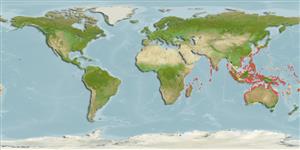Teleostei (teleosts) >
Gobiiformes (Gobies) >
Gobiidae (Gobies) > Gobiinae
Etymology: Barbuligobius: Latin barba,-ae; barbula = beard + Latin, gobius = gudgeon (Ref. 45335).
Eponymy: James Erwin Böhlke (1930–1982) and his wife Eugenia Louisa Böhlke née Brandt (1929–2001) were both ichthyologists who worked at the Academy of Natural Sciences of Philadelphia, where he was Curator of Ichthyology (1954–1982). [...] (Ref. 128868), visit book page.
More on authors: Lachner & McKinney.
Environment: milieu / climate zone / depth range / distribution range
Ecology
Marine; demersal; depth range 1 - 15 m (Ref. 90102). Tropical
Indo-West Pacific.
Size / Weight / Age
Maturity: Lm ? range ? - ? cm
Max length : 2.0 cm SL male/unsexed; (Ref. 559)
Dorsal spines (total): 7; Dorsal soft rays (total): 8 - 9; Anal spines: 1; Anal soft rays: 8 - 9. Characterized by light tan body color with row of five horizontally elongate black spots along middle of side; presence of row of smaller dark spots along lower side of body; nape, back and upper caudal peduncle with six brown saddles; joined pelvic fins, relatively long , extends beyond anal fin; rounded caudal fin; longitudinal scale series 23-25; absence of scales on nape, cheek, opercle, breast and anterior body; numerous, elongate, fleshy barbels and flaps on head; depth of body 5.6-6.3 in SL (Ref. 90102).
Inhabits sand-rubble bottoms, usually in surge channels or on exposed outer edge of reefs in 1-15 m (Ref. 90102). Burrows in sand adjacent to coral or rock (Ref. 2798).
Life cycle and mating behavior
Maturity | Reproduction | Spawning | Eggs | Fecundity | Larvae
Hoese, D.F., 1986. Gobiidae. p. 774-807. In M.M. Smith and P.C. Heemstra (eds.) Smiths' sea fishes. Springer-Verlag, Berlin. (Ref. 2798)
IUCN Red List Status (Ref. 130435: Version 2024-1)
Threat to humans
Harmless
Human uses
Tools
Special reports
Download XML
Internet sources
Estimates based on models
Preferred temperature (Ref.
123201): 22 - 29.3, mean 28.3 °C (based on 2614 cells).
Phylogenetic diversity index (Ref.
82804): PD
50 = 1.0000 [Uniqueness, from 0.5 = low to 2.0 = high].
Bayesian length-weight: a=0.01023 (0.00477 - 0.02194), b=3.01 (2.83 - 3.19), in cm total length, based on LWR estimates for this (Sub)family-body shape (Ref.
93245).
Trophic level (Ref.
69278): 3.0 ±0.3 se; based on size and trophs of closest relatives
Resilience (Ref.
120179): High, minimum population doubling time less than 15 months (Preliminary K or Fecundity.).
Fishing Vulnerability (Ref.
59153): Low vulnerability (10 of 100).
